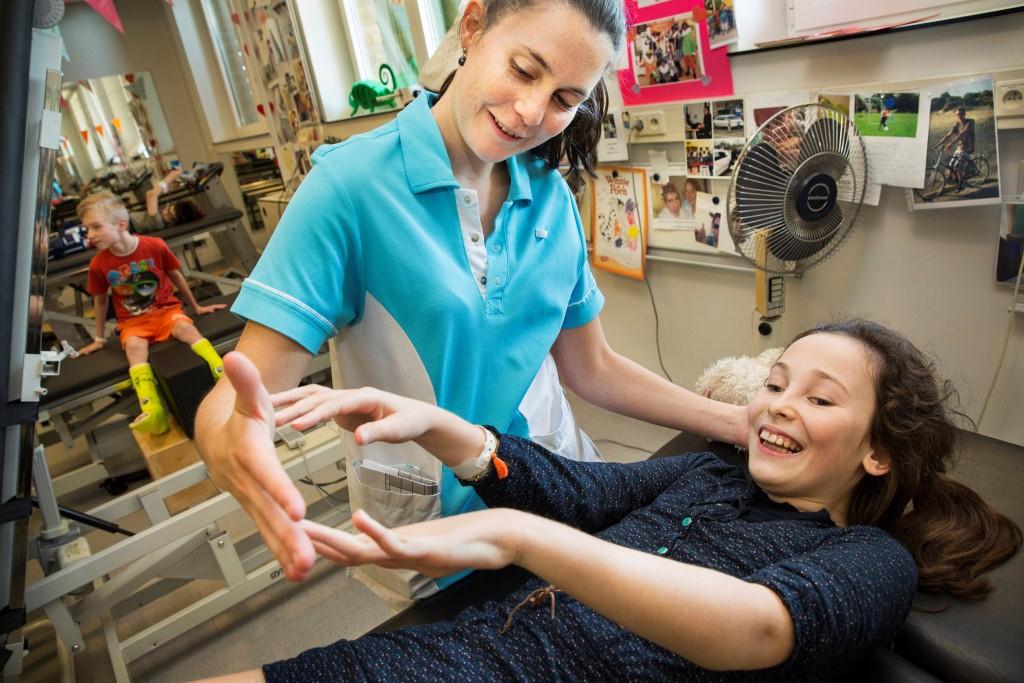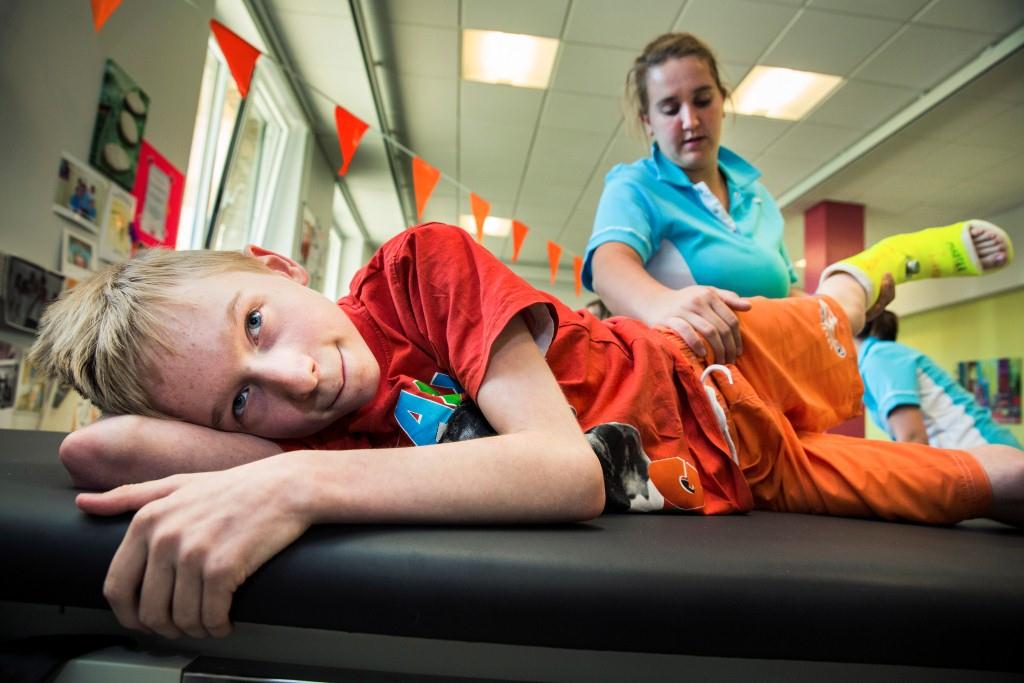Effectiveness of passive stretching in children with cerebral palsy
Neurological disorders often cause increased muscle tone — too much tightness — in muscles of the arms and legs. Spasticity results from significantly increased muscle tone, limiting movement and joint mobility. Cerebral palsy — a neurological disorder that develops in childhood — causes spasticity for many people with the disorder, and passive stretching is a technique used to reduce the muscle tightness.

One way to reduce the muscle tone is to inject botuline toxine, better known as botox, in the children’s muscles. This enables the physiotherapist to stretch and intensively train the muscles. Molenaers: “One advantage of a child’s brain and nervous system is that it’s elastic to some extent. Dieter Telemans photo, Children’s Rehabilitation Department of UZ Leuven Pellenberg.
by Aubrey Bailey, Chron
| Overview |
Spastic CP is characterized by tight muscles, causing decreased range of motion and limited joint mobility. Spasticity typically affects the calf muscle, pulling the toes down toward the floor and lifting the heel off the ground. In the thighs, spasticity affects the adductor muscles — muscles on the inside of the thigh that bring the legs toward each other.
This leads to a scissoring gait, with 1 foot crossing in front of the other with each step. In the arm, excessive muscle tightness affects the muscles that bend the fingers, wrist and elbow, drawing the arm in toward the body. Arm spasticity significantly affects a person’s ability to care for himself, as well as other daily tasks.

Six months ago, 13-year-old Georges Vermast rode her bike for the first time in her life – from her home in the coastal city of Oostduinkerke straight to the beach. Even though she wasn’t riding a real bike but a tricycle, it was a remarkable achievement and a demonstration of how endurance and devotion can eventually pay off. A year before, Georges had been bound to her wheelchair, believing she would never be able to ride a bike or even walk independently. Dieter Telemans photo, Children’s Rehabilitation Department of UZ Leuven Pellenberg
| Passive Stretching |
Passive stretching uses an external force to stretch muscles that are tight. Physical therapists frequently use passive stretching to treat people with spastic CP. The muscles are stretched by placing the joint in the opposite position of the tightness. For example, a tight calf pulls the toes down toward the floor. To stretch this muscle, the foot is gently pressed up, bringing the toes toward the person’s head. This position is held for approximately 30 seconds and repeated several times.
Passive stretching should not be painful — overstretching can lead to muscle damage. Passive stretching can also be done using splints to hold the affected body part in a stretched position. For example, a knee-ankle-foot orthosis can be worn to hold the knee straight and the ankle bent to approximately 90 degrees. These splints are worn during rest periods or at night because they significantly limit movements.
| Research |
According to Physical Medicine & Rehabilitation Clinics of North America, passive stretching alone is not effective for long-term improvement in muscle length for children with CP. Although passive stretching continues to be a common, longstanding component of physical therapy programs, research has failed to prove its long-term effectiveness.
A study published in Journal of Applied Physiology in August 2011 examined the effectiveness of passive stretching combined with active exercise as a treatment for children with CP. The results indicated this combination was effective for reducing muscle stiffness in the calf muscles of the participants.
According to a 2011 article in BMC Pediatrics, it is considered to be general knowledge that splints are effective for reducing muscle tightness caused by CP. For example, it is assumed a knee-ankle-foot orthosis will decrease tightness in the calf muscle when worn for 6 or more hours per day. However, there is limited evidence in the research to support this belief.
| Clinical Application |
Despite the lack of scientific evidence, physical therapists frequently use passive stretching as part of the treatment plan for children with CP. Passive stretching decreases muscle tightness, making it easier to put on orthotics before gait training. Children also report improved comfort with passive stretching because it temporarily reduces tightness.
| Aubrey Bailey has been writing health-related articles since 2009. Her articles have appeared in ADVANCE for Physical Therapy & Rehab Medicine. She holds a Bachelor of Science in physical therapy and Bachelor of Arts in psychology from the University at Buffalo, as well as a post-professional Doctor of Physical Therapy from Utica College. Dr. Bailey is also a certified hand therapist. |
Source Chron
| References |
The effectiveness of passive stretching in children with cerebral palsy, Pin T, Dyke P, Chan M. Dev Med Child Neurol. 2006 Oct;48(10):855-62.
Centers for Disease Control and Prevention: Data & Statistics for Cerebral Palsy, Content source: Division of Birth Defects and Developmental Disabilities, National Center on Birth Defects and Developmental Disabilities, CDC
Changes of calf muscle-tendon biomechanical properties induced by passive-stretching and active-movement training in children with cerebral palsy, Heng Zhao, Yi-Ning Wu, Miriam Hwang, Yupeng Ren, Fan Gao, Deborah Gaebler-Spira, and Li-Qun Zhang. J Appl Physiol (1985). 2011 Aug; 111(2): 435–442. Published online 2011 May 19. doi: 10.1152/japplphysiol.01361.2010
Cerebral Palsy Handout, James Madison University
Splint: the efficacy of orthotic management in rest to prevent equinus in children with cerebral palsy, a randomised controlled trial, Josina C Maas, Annet J Dallmeijer, Peter A Huijing, Janice E Brunstrom-Hernandez, Petra J van Kampen, Richard T Jaspers, and Jules G Becher. BMC Pediatr. 2012; 12: 38. Published online 2012 Mar 26. doi: 10.1186/1471-2431-12-38
Managing spastic hypertonia in children with cerebral palsy via repetitive passive knee movements, Cheng HY, Ju YY, Chen CL, Wong MK. J Rehabil Med. 2012 Mar;44(3):235-40. doi: 10.2340/16501977-0937.
Rehabilitative Therapies in Cerebral Palsy: The Good, the Not As Good, and the Possible, Diane L. Damiano PhD PT. J Child Neurol. Author manuscript; available in PMC 2010 Nov 16. Published in final edited form as: J Child Neurol. 2009 Sep; 24(9): 1200–1204. Published online 2009 Jun 12. doi: 10.1177/0883073809337919
New Clinical and Research Trends in Lower Extremity Management for Ambulatory Children with Cerebral Palsy, Diane L. Damiano PhD PT, Katharine E. Alter MD, and Henry Chambers MD. Phys Med Rehabil Clin N Am. Author manuscript; available in PMC 2010 Nov 12. Published in final edited form as: Phys Med Rehabil Clin N Am. 2009 Aug; 20(3): 469–491. doi: 10.1016/j.pmr.2009.04.005
| Further reading |
Combined passive stretching and active movement rehabilitation of lower-limb impairments in children with cerebral palsy using a portable robot, Wu YN, Hwang M, Ren Y, Gaebler-Spira D, Zhang LQ. Neurorehabil Neural Repair. 2011 May;25(4):378-85. doi: 10.1177/1545968310388666. Epub 2011 Feb 22.
Managing lower extremity muscle tone and function in children with cerebral palsy via eight-week repetitive passive knee movement intervention, Cheng HY, Ju YY, Chen CL, Chang YJ, Wong AM. Res Dev Disabil. 2013 Jan;34(1):554-61. doi: 10.1016/j.ridd.2012.09.020. Epub 2012 Nov 1.
Home-based tele-assisted robotic rehabilitation of joint impairments in children with cerebral palsy, Chen K, Ren Y, Gaebler-Spira D, Zhang LQ. Conf Proc IEEE Eng Med Biol Soc. 2014;2014:5288-91. doi: 10.1109/EMBC.2014.6944819.
Home-Based Versus Laboratory-Based Robotic Ankle Training for Children With Cerebral Palsy: A Pilot Randomized Comparative Trial, Chen K, Wu YN, Ren Y, Liu L, Gaebler-Spira D, Tankard K, Lee J, Song W, Wang M, Zhang LQ. Arch Phys Med Rehabil. 2016 Aug;97(8):1237-43. doi: 10.1016/j.apmr.2016.01.029. Epub 2016 Feb 20.
Also see
Rehabilitation centre helps children with cerebral palsy Flanders Today
TheraSuits and Cerebral Palsy Chron
How to Release Muscle Spasticity With Stretches Chron
